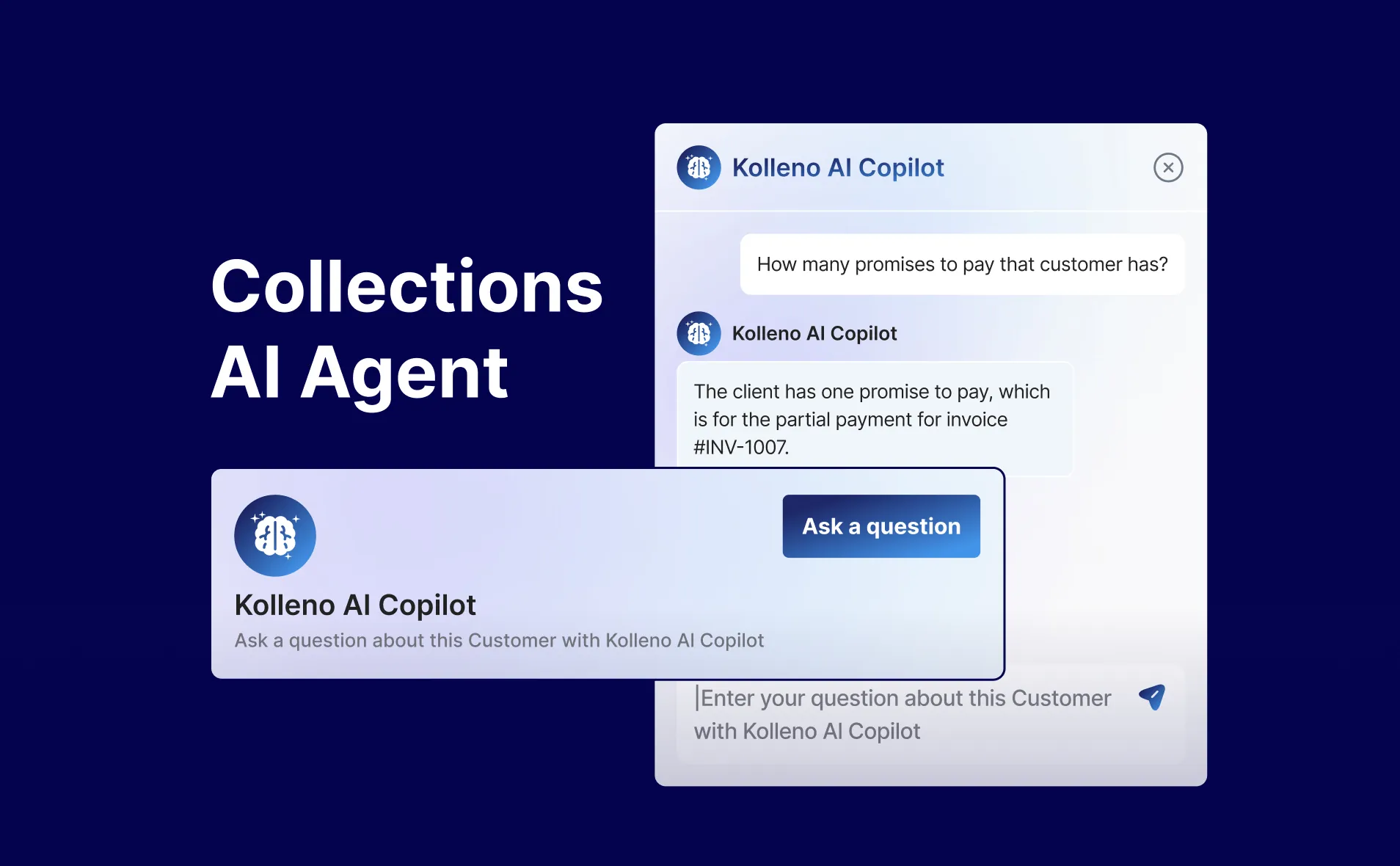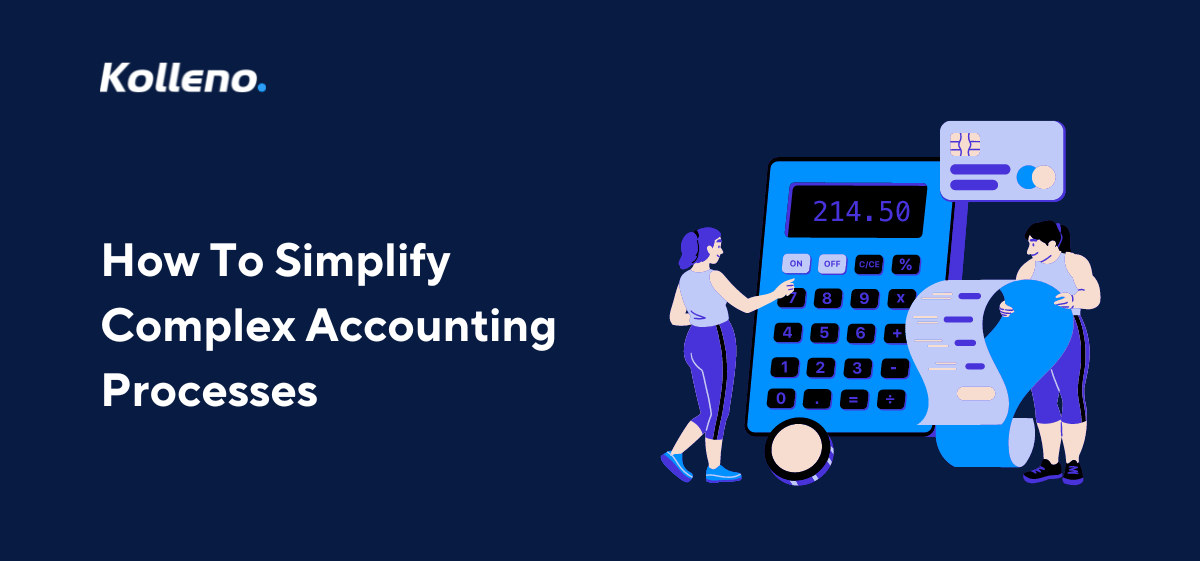Introduction
Managing complex accounting processes can be really overwhelming and stressful, but with the right strategies and technologies, these processes can be significantly simplified and actually improved, leading to higher efficiency. In this blog, we’ll uncover the common challenges in accounting and provide actionable strategies to help you simplify these processes.
Understanding the Challenges
1. Tedious, Repetitive, and Time-Consuming Manual Processes
Manual accounting tasks are not only time-consuming but also highly prone to errors. Many businesses still rely heavily on Excel spreadsheets for their financial operations. While Excel is a powerful tool, it’s not designed to handle the complexities of modern accounting needs. Here are some issues with manual processes:
- Human Error: Every manual entry increases the risk of mistakes, from simple typos to significant financial miscalculations.
- Inefficiency: Manual data entry is labour-intensive and consumes valuable time that could be better spent on strategic tasks.
- Data Management: Keeping track of numerous spreadsheets and ensuring they are updated correctly is cumbersome and inefficient.
2. Lack of Visibility and Full Control
When accounting data is scattered across multiple systems and departments, it becomes challenging to get a comprehensive view of the organisation’s financial health. This lack of visibility can lead to several issues:
- Data Silos: Isolated pockets of data within different departments hinder a unified approach to financial management.
- Delayed Reporting: Consolidating data from various sources for reporting is time-consuming and often leads to delays.
- Inconsistent Data: Discrepancies in data from different systems can cause confusion and errors in financial statements.
3. No Access to Real-Time Data
Real-time data is crucial for making informed and timely decisions. However, manual processes and decentralised data storage often mean that the information is outdated by the time it’s reviewed. This lack of real-time data access can have several consequences:
- Delayed Decision-Making: Without up-to-date information, businesses cannot make swift decisions in response to market changes.
- Missed Opportunities: The inability to access real-time data can result in missed opportunities for cost savings and revenue generation.
- Inaccurate Forecasting: Outdated data leads to inaccurate financial forecasts, affecting strategic planning and budgeting.
4. Numerous Errors in Data
Errors in financial data can have far-reaching implications, from minor discrepancies to major financial misstatements. The root causes of these errors in complex accounting processes include:
- Manual Entry Mistakes: Simple errors like incorrect data entry or missed entries can lead to significant financial inaccuracies.
- Reconciliation Issues: Manually reconciling accounts is prone to errors, making it difficult to match transactions accurately.
- Audit Challenges: Errors in data make audits more challenging and time-consuming, potentially leading to compliance issues and penalties.
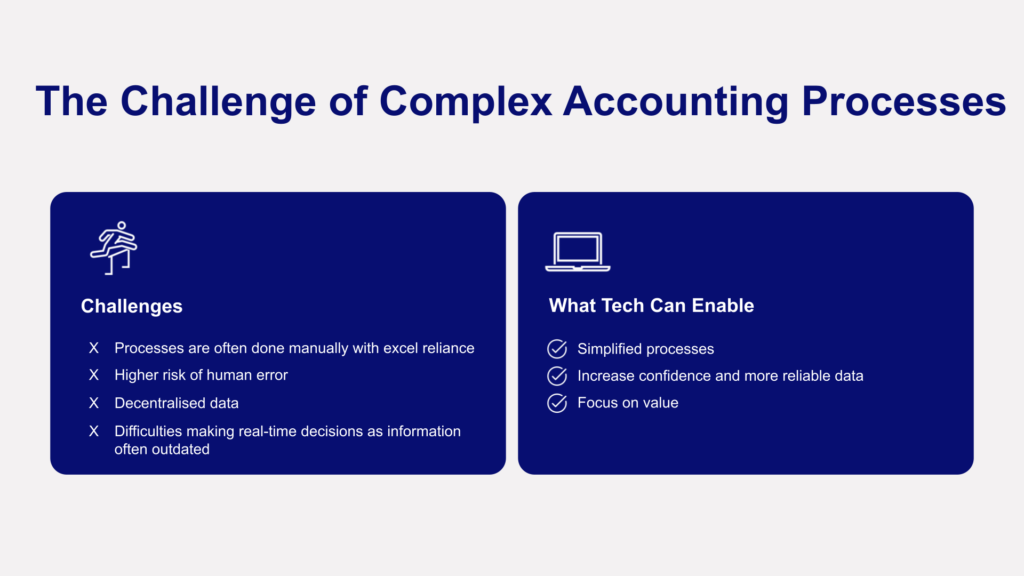
Impact of Legacy AR Management Processes
Traditional Accounts Receivable (AR) management processes involve several steps that are prone to inefficiencies and errors:
- Manual Invoicing: Paper-based invoicing and manual reminders increase the likelihood of errors and delays.
- Non-Automated Processes: Manual tracking and chasing of overdue payments can be time-consuming and lead to missed tasks.
- Non-Digital Payments: Methods like cheques add friction and slow down the payment process, complicating reconciliation.
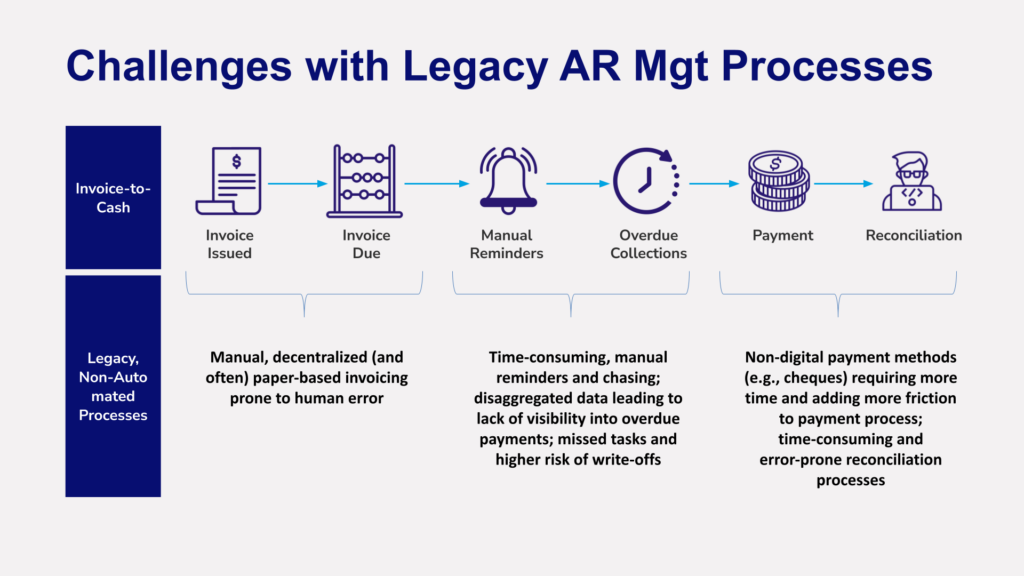
How to solve these challenges and improve AR Management with technology
Addressing the critical challenges in Accounts Receivable (AR) management requires leveraging modern technology to streamline processes and enhance efficiency. Here are detailed strategies on how technology can help improve AR management:
1. Digitization of Invoicing
Implementing digital invoicing processes can centralise data, improve accuracy, and streamline the entire invoicing workflow. Key benefits include:
- Centralised Data: Digital invoicing consolidates all invoice-related data into a single, easily accessible platform. This centralisation ensures that information is consistently up-to-date and readily available.
- Improved Accuracy: Automating invoicing reduces the risk of human errors associated with manual data entry. Digital invoices can be generated automatically based on predefined templates and data inputs, ensuring consistency and accuracy.
- Speed and Efficiency: Automated invoicing speeds up the entire process, from invoice generation to delivery. Invoices can be sent electronically, reaching customers instantly and reducing delays associated with traditional mailing methods.
- Integration with ERP Systems: Integrating digital invoicing with Enterprise Resource Planning (ERP) systems allows for seamless data flow and real-time updates. This integration enhances overall financial management and reporting capabilities.
2. Automated Workflows
Automation of AR processes can significantly reduce the manual effort required to manage and track payments. Key features include:
- Personalised Reminders: Automated systems can send personalised reminders for late payments via multiple channels, such as SMS, email, and phone. These reminders can be tailored to each customer’s payment history and preferences, increasing the likelihood of timely payments.
- Multi-Channel Communication: Using various communication channels ensures that reminders reach customers through their preferred method, improving response rates.
- Efficient Payment Tracking: Automated workflows enable real-time tracking of payments, reducing the incidence of overdue accounts. This real-time visibility allows businesses to take proactive measures to address late payments.
- Reduction of Manual Tasks: By automating routine tasks such as sending reminders and tracking payments, finance teams can focus on more strategic activities that add value to the organisation.
3. Digital Payments
Offering digital payment options can simplify and expedite the payment process for both businesses and their customers. Advantages include:
- Convenience and Flexibility: Digital payment solutions offer convenience for customers, allowing them to pay invoices quickly and easily using various methods such as credit cards, online banking, and mobile payment apps. Tailored payment plans can also be offered to accommodate different customer needs and improve cash flow.
- Faster Payment Processing: Digital payments are processed much faster than traditional methods, such as cheques, reducing the time it takes for funds to be received and cleared.
- Automated Reconciliation: Digital payments can be automatically reconciled with invoices, reducing the time and effort required for manual reconciliation. Automated systems match payments with outstanding invoices, ensuring accuracy and minimizing discrepancies.
- Enhanced Security: Digital payment platforms often come with advanced security features that protect against fraud and ensure the safe handling of financial transactions.
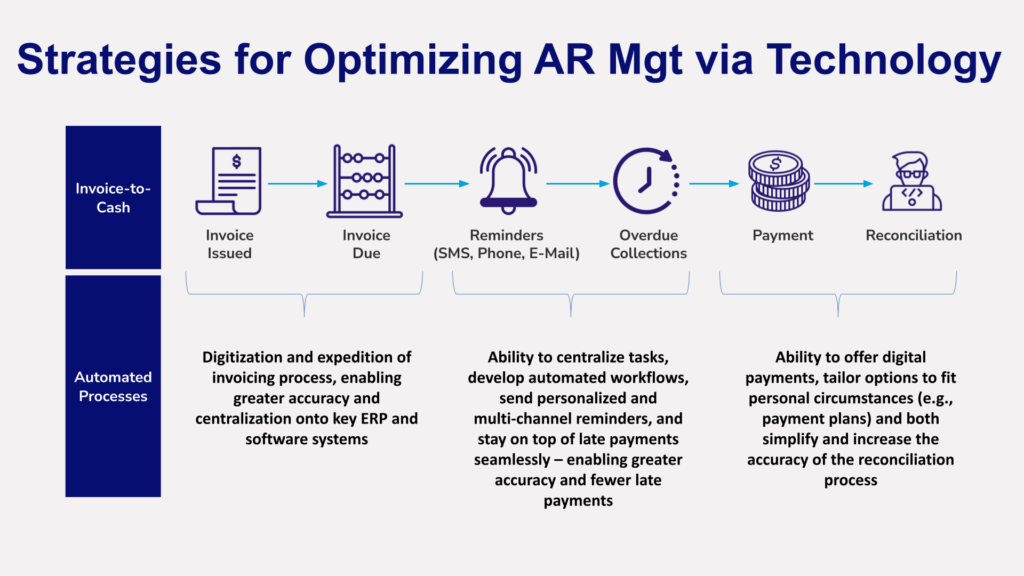
Implementing Technology for AR Management
To successfully implement these technological solutions, organisations should follow these steps:
1. Assess Current Processes: Conduct a thorough assessment of existing AR processes to identify areas for improvement and determine the specific needs of the organisation.
2. Select the Right Tools: Choose software and tools that integrate well with existing systems and meet the organization’s requirements. Look for features such as automation, digital invoicing, and payment processing capabilities.
3. Train Staff: Ensure that finance teams are adequately trained to use the new technology. Provide ongoing support and resources to help them adapt to new processes.
4. Monitor and Optimise: Continuously monitor the performance of the new systems and make adjustments as needed. Use data analytics to gain insights into AR performance and identify further opportunities for optimization.
By leveraging technology to digitise invoicing, automate workflows, and facilitate digital payments, organisations can overcome the challenges of complex AR management. These solutions not only enhance efficiency and accuracy but also improve cash flow and overall financial health.
Conclusion
Simplifying complex accounting processes is essential for modern businesses aiming to stay competitive and agile. By addressing the challenges of manual processes, decentralised data, and outdated information through technology and strategic optimisation, organisations can achieve greater accuracy, efficiency, and financial stability.
